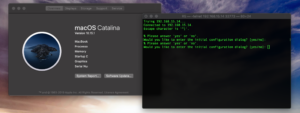Can you install macOS Catalina on an external SSD connected to your Mac? Yes, it's definitely possible. However, since Apple initiated a relatively new partition scheme (APFS) with macOS High Sierra, the process is slightly different than with older versions of macOS. This list will be updated as other compatible models become available. If you're using one of these computers with OS X Mavericks or later, you can install macOS Catalina. Your Mac also needs at least 4GB of memory and 12.5GB of available storage space, or up to 18.5GB of storage space when upgrading from OS X Yosemite or earlier. MacOS Catalina (10.15) The sixteenth big update of macOS, Apple Inc.’s desktop operating system for Macintosh computers, is called Catalina.It is the successor to macOS Mojave and was unveiled on June 3, 2019, at WWDC 2019 and launched to the general public on October 7, 2019.
As you can see, since the update on Mac OS X 10.7 Lion, the system has lost the ability to enable an FTP server for sharing files and folders. It’s unclear why Apple removed the graphical interface for enabling FTP sharing, but you can still start a local FTP (or SFTP) server on macOS using the command line.
If you use the command line, you probably noticed that the latest versions of macOS do not have FTP file transfer protocol.
By default, FTP is not installed in the latest versions of the system, but this does not mean that you cannot install the protocol yourself. Modern versions of macOS use SFTP instead of FTP. SFTP has more secure encryption.
However, some users still prefer FTP. If you don’t need FTP, then there’s no reason to install it.
How to Install FTP in macOS
If you still haven’t installed Homebrew on a Mac, you need to do this before proceeding with the instructions below.
We will do this by installing inetutils. And this is done through Homebrew. If you haven’t Homebrew in your system, you can take script for Homebrew installing here.
Installation Using inetutils
The inetutils file contains: FTP, FTP server, telnet and telnet server, as well as rsh, rlogin, tfp servers and clients, etc. If you need FTP protocol, it will not hurt to install the entire set.
To do this, use the following command:
When Homebrew finishes installing inetutils, you can run the FTP command as usual. For example, you can connect to the gnu.org server to check that everything worked out.
One of the advantages of this method is that you also get other useful tools in the kit, and you will not need to install them manually.
How to Start FTP and SFTP Server in macOS
Naturally, it is possible to download a separate server and many do, but why, if the mac out of the box already has a built-in ftp / sptp server, which is enough for most tasks. Simply, the built-in server is disabled by default and we just need to enable it. This is what we will do.
Start FTP server in macOS
First, start the Terminal (/Applications/Utilities/Terminal.app) and run the following command:
Check if the server is working with the ftp localhost command. If you see something similar in the terminal window:
So everything turned out and the server works. To connect to the server, use your account or create a new one, especially for ftp connections (which will be more correct from a security point of view). To access files on the server, use the “connect to server” command in the Finder or using any ftp client.
Start SFTP server in macOS
As you know, the FTP server transmits data in unencrypted form and, as a result, for security reasons, it is not very reliable.
To exchange information securely, you need to use an SFTP server, for this:
- If, for security reasons, you still need to encrypt the transmitted data, then enter the “System Preferences”->“Sharing”;
- Check the box next to “Remote Login”;
- In the “Allow access” block, it is advisable to select the “Only these users” option and Specify your users.
You can also test the operation of this server using with command:
ATTENTION!!!
FTP and SFTP servers may conflict with each other and it is not recommended to keep them enabled at the same time.
Server Shutdown
The built-in SFTP server is disabled by unchecking the Remote login option in the system settings.
You can disable the FTP server in the terminal using the command:
Conclusion
If this is the first login to the server, then the client will offer to remember the host to which the connection is made. You can confirm this action by typing the word “yes” in the console and pressing the “Enter” key. Otherwise, type “no” and press “Enter”.
Next, you need to enter a password, if all the data has been entered correctly, the client will successfully connect to the server.
When macOS High Sierra (10.13) was released, the telnet utility disappeared. This has probably been a good move by Apple since telnet is outdated and not a secure protocol; it shouldn't be used in general. However, telnet did serve a useful function - checking if it was possible to connect to a remote server on a particular port. Luckily there is a much better tool for this included in macOS - nc (netcat).
Using nc
 is simple and it has command line arguments that are very similar to telnet. I like to use the -vz arguments whenever I need to check if a remote server can be reached on a particular port. These arguments make
is simple and it has command line arguments that are very similar to telnet. I like to use the -vz arguments whenever I need to check if a remote server can be reached on a particular port. These arguments make Install Telnet Mac Os Catalina Free
nc have this behaviour...-z Specifies that nc should just scan for listening daemons, without sending any data to them.
The result is nc tries to connect to the server and then immediately terminates if it succeeds. Here's an example...
nc output

Install Telnet Mac Os Catalina Update
How Do I Install Telnet On A Mac
If a connection cannot be established and a timeout is reached the output is like this (timeout can be controlled via the -G option i.e. -G 5)...
nc output
If a connection is refused, the output is like this...
How To Install Telnet On Mac Catalina
Install Telnet Macos Catalina
nc outputInstall Telnet Mac Os Catalina Download
-i